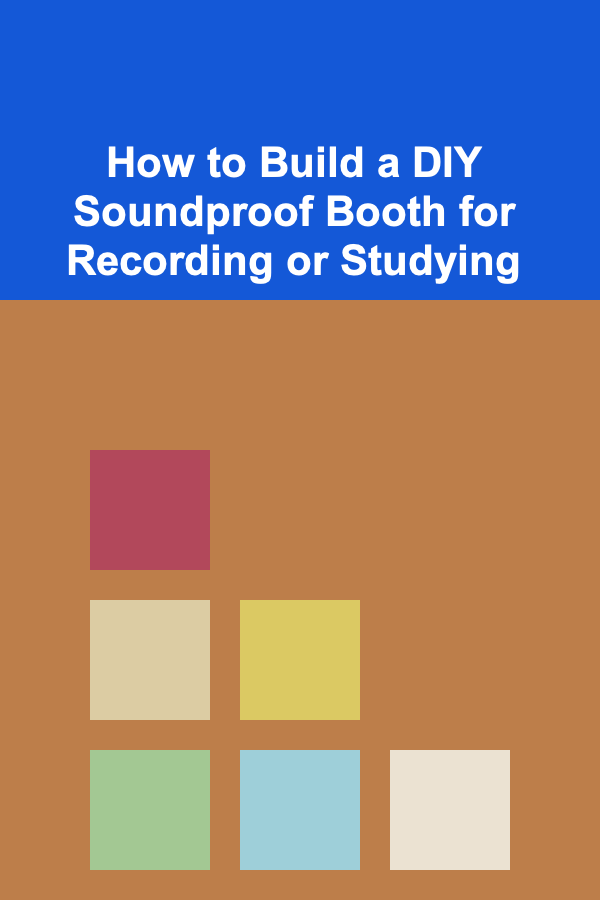
How to Build a DIY Soundproof Booth for Recording or Studying
ebook include PDF & Audio bundle (Micro Guide)
$12.99$11.99
Limited Time Offer! Order within the next:

Creating an ideal environment for recording or studying requires a space that is quiet, free from distractions, and acoustically optimized. If you don't have access to a professional studio or a dedicated soundproof room, building a DIY soundproof booth can be a cost-effective and practical solution. Whether you're recording a podcast, doing voice-over work, practicing music, or simply seeking a quiet space to study, a soundproof booth can make all the difference in the quality of your work or focus.
In this guide, we will take you step by step through the process of building a DIY soundproof booth, offering insight into materials, tools, techniques, and design principles that will help you achieve a professional-quality setup. From the basic principles of soundproofing to the specifics of building a compact, functional booth, this article covers everything you need to create a productive and noise-free environment.
Understanding the Basics of Soundproofing
Before embarking on the construction of your soundproof booth, it's essential to understand the key principles of soundproofing. Soundproofing involves reducing the transmission of sound between spaces. This can be achieved through three main strategies:
- Absorption: Absorbing sound energy using materials that trap sound waves and prevent them from bouncing off surfaces.
- Decoupling: Separating surfaces to prevent vibrations from transferring sound between walls, floors, or ceilings.
- Blocking: Adding mass and density to barriers (such as walls and doors) to reduce sound penetration.
A soundproof booth relies on a combination of these techniques to create a quiet space. The goal is to minimize sound leakage both from the outside world and within the booth itself.
Step 1: Plan Your Space and Determine Dimensions
Space Requirements
The first step in building a DIY soundproof booth is deciding on the size and layout of the booth. Consider the following factors:
- Available Space: How much room do you have in your home or studio to allocate to a soundproof booth? It should be a quiet corner or area that won't interfere with your other activities.
- Purpose of the Booth: Are you building it for recording, studying, or both? If it's for recording, you'll need enough space for your microphone, sound equipment, and perhaps a small desk or chair.
- Ventilation: Soundproofing typically makes a space more airtight, which can lead to poor airflow. Plan for a way to introduce fresh air into the booth, such as using vent baffles or a small ventilation fan.
Dimensions
When it comes to the size of the booth, a small, compact booth will suffice for most recording or studying purposes. For recording, a booth size of 3x3 feet to 4x4 feet is adequate. For studying, a larger booth may be necessary if you need extra room for furniture like desks or bookshelves.
Step 2: Gather Materials
Building a soundproof booth requires a range of materials that will help to absorb sound, block noise, and decouple vibrations. Here's a breakdown of essential materials for your DIY soundproof booth:
1. Soundproofing Foam Panels
Acoustic foam panels are essential for absorbing sound inside the booth. These panels help to prevent sound reflections and echoes, ensuring that your recordings are clear and professional. You'll want to cover as much of the interior surface as possible with foam.
- Design Tip: Choose thicker, high-density foam panels for better sound absorption. Opt for different shapes like wedges or pyramids to maximize sound absorption efficiency.
2. Mass-Loaded Vinyl (MLV)
Mass-loaded vinyl is a dense material used for soundproofing that can be applied to walls, ceilings, and floors to block sound from entering or leaving the booth. It's particularly useful for creating barriers that are heavy enough to block low-frequency noise.
- Design Tip: MLV should be installed between layers of drywall or other materials for optimal soundproofing. Make sure the seams are sealed to prevent sound leakage.
3. Acoustic Insulation (Mineral Wool or Fiberglass)
Mineral wool or fiberglass insulation is placed between the walls of your booth to further absorb sound and reduce vibrations. These materials are ideal for preventing sound from traveling through the walls.
- Design Tip: If you're constructing a fully enclosed booth, consider using mineral wool as it is an effective and cost-efficient material for blocking sound.
4. Drywall or Plywood
For the external structure of your booth, drywall or plywood will be required to form the walls, ceiling, and floor. Drywall provides mass and density for soundproofing, while plywood is easy to work with and strong enough for structural integrity.
- Design Tip: Layering drywall with insulation and MLV between the layers is an effective strategy to block sound. A double layer of drywall will provide extra density and soundproofing.
5. Sealant and Caulk
To seal gaps around the edges of the booth, you'll need high-quality acoustical sealant or caulk. Sound can travel through even the smallest cracks, so sealing these gaps is essential.
- Design Tip: Pay special attention to door seams and any electrical outlets, as these areas are often the most prone to sound leakage.
6. Ventilation Components
To ensure your booth is breathable, you'll need a way to introduce fresh air. Look for a quiet venting solution, such as a vent baffle system or small ventilation fan, which can circulate air without letting noise enter the booth.
Step 3: Build the Structure of the Booth
Now that you've gathered your materials, it's time to start constructing the booth. Follow these steps for a basic build:
1. Build the Frame
Start by constructing the frame of the booth. If you're using wood, 2x4 lumber will be sturdy enough to form the walls and roof. Cut the wood into appropriate lengths and assemble the frame using screws or nails. Ensure that the frame is square and level for structural integrity.
- Design Tip: Build the frame as a free-standing unit rather than attaching it directly to the walls of the room. This prevents vibrations from traveling between the booth and the room.
2. Add Insulation and Mass-Loaded Vinyl
Once the frame is assembled, fill the cavity between the wooden studs with insulation, such as mineral wool or fiberglass. After installing the insulation, attach mass-loaded vinyl to the interior surfaces of the walls, ceiling, and floor. Overlap the seams of the MLV to ensure complete coverage.
- Design Tip: For added soundproofing, you can apply two layers of MLV, with a layer of insulation between them, to further block sound.
3. Install the Drywall or Plywood
Next, install drywall or plywood over the frame, ensuring that it's firmly secured with screws. If you're using drywall, it may be helpful to apply a layer of Green Glue (a soundproofing compound) between the drywall layers to further dampen sound transmission.
- Design Tip: To minimize vibrations, attach the drywall using resilient channels, which decouple the drywall from the frame and prevent sound from traveling through the structure.
4. Seal Gaps
After the drywall or plywood is in place, seal all the seams and edges with acoustic sealant or caulk. This includes gaps around the door, windows (if applicable), and any electrical outlets. Pay special attention to any areas where sound can leak through.
- Design Tip: Use a caulk gun to apply the sealant smoothly and consistently, ensuring that there are no gaps for sound to escape.
Step 4: Soundproof the Door and Windows
In a DIY soundproof booth, the door and any windows (if used) are critical points of potential sound leakage. Here's how to soundproof these areas:
1. Soundproofing the Door
The door should be as soundproof as possible to prevent external noise from entering. You can achieve this by using a heavy, solid-core door or by adding soundproofing materials to a pre-existing door.
- Design Tip: Consider using weatherstripping or door seals around the doorframe to seal any gaps that might let sound in. You can also use an acoustic door sweep at the bottom of the door.
2. Soundproofing Windows
If your booth includes windows, it's important to use double-glazed or laminated glass to minimize sound penetration. If replacing the window isn't feasible, you can add an acoustic window insert that fits over the existing glass to reduce noise.
- Design Tip: Apply a layer of soundproofing film or acoustic panels directly to the window to improve its sound-blocking capability.
Step 5: Add Acoustic Treatment and Furnishings
Once the structural soundproofing is in place, it's time to add acoustic treatment and make the space functional for your needs.
1. Acoustic Foam Panels
Cover the interior walls of the booth with high-density foam panels to absorb sound reflections and echoes. Focus on placing the foam on the walls, ceiling, and floor where sound tends to bounce.
- Design Tip: For a more professional aesthetic, arrange the foam in an interesting pattern or use custom-colored foam panels that complement the booth's design.
2. Furniture and Equipment
Now that the booth is constructed, furnish it with the necessary equipment for your recording or studying purposes. This might include a desk, chair, microphone stand, headphones, and sound recording equipment.
- Design Tip: Keep furniture minimal to avoid clutter. Choose furniture with soft, absorbent materials to help further dampen sound and reduce vibrations.
Step 6: Test and Fine-Tune
Once the booth is complete, it's important to test its acoustic performance. Record some test audio or spend time studying in the booth to see how well the soundproofing works. If you notice any areas where sound leakage is still an issue, apply additional sealant or foam to improve performance.
1. Sound Testing
Use a sound level meter or a smartphone app to measure the noise levels inside and outside the booth. This will help you identify areas where sound might still be leaking or where additional treatment is needed.
- Design Tip: Record some sample audio in the booth and listen for any unwanted background noise or echoes. Fine-tune the setup by adding more absorption materials or making adjustments as needed.
Conclusion
Building a DIY soundproof booth for recording or studying can seem like a challenging task, but with the right materials, tools, and techniques, it's a highly achievable project. By understanding the fundamentals of soundproofing, gathering the right materials, and following a step-by-step process, you can create a functional, quiet space that meets your needs. Whether you're recording high-quality audio for podcasts or voiceovers, or simply seeking a peaceful space to concentrate, a well-built soundproof booth can make a world of difference in your productivity and comfort.
Investing time and effort into creating a soundproof environment will ultimately help you produce better work, focus more effectively, and enjoy a quieter, more comfortable workspace.
Reading More From Our Other Websites
- [Organization Tip 101] How to Use Cloud Storage for Effective File Management
- [Screen Printing Tip 101] Mastering the Art of Screen Printing Stencils: A Beginner's Guide
- [Personal Care Tips 101] How to Pick the Right Mouthwash for Preventing Cavities
- [Home Cleaning 101] How to Clean and Store Your Garden Tools
- [Gardening 101] From Succulents to Grasses: The Best Drought‑Resistant Perennials for Every Climate
- [Small Business 101] Boost Your Brand with Social Media Marketing for Small Business
- [Small Business 101] Best Techniques for Conducting Virtual Focus Groups on a Shoestring Budget
- [Home Maintenance 101] How to Maintain Your Home's Carpet for Longer Use
- [Home Rental Property 101] How to Market Your Rental Property Online (Beyond the Big Sites)
- [Personal Financial Planning 101] How to Use Credit Cards Responsibly to Build Your Credit Score

How to Avoid Hidden Fees That Can Blow Your Home Budget
Read More
How to Choose the Right Backsplash for Your Kitchen Renovation
Read More
How to Incorporate Modern Design Trends in Your Home Staging
Read More
How to Reduce Unnecessary Expenses Without Sacrificing Quality
Read More
How to Utilize Drawer Organizers for Small Items
Read More
How To Discover Advances in Spinal Cord Injury Treatment
Read MoreOther Products

How to Avoid Hidden Fees That Can Blow Your Home Budget
Read More
How to Choose the Right Backsplash for Your Kitchen Renovation
Read More
How to Incorporate Modern Design Trends in Your Home Staging
Read More
How to Reduce Unnecessary Expenses Without Sacrificing Quality
Read More
How to Utilize Drawer Organizers for Small Items
Read More